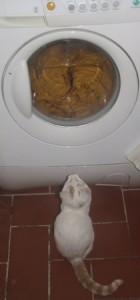There is no easy way to say this, so here goes: about two weeks ago, Stefano’s father was diagnosed with Stage III invasive melanoma, based on the biopsy of an itsy bitsy spot on his cheek, which, he said, didn’t bother him in the least but was “wet.” As soon as the biopsy results came in, my father-in-law was scheduled for more invasive surgery (=next week). Last week, therefore, he had a bunch of pre-surgery tests.
Then on Thursday my father-in-law went to see the oncologist/surgeon, Dr. G. (one of the best in Florence), who gave him the results of the CAT Scan: unfortunately, the cancer has spread to his lungs…
Stefano has been home all week with a bad case of bronchitis, which is being treated with heavy duty antibiotic injections and cortisone. And now…this bad news about his father…
Eh, I won’t hide that this has been a very difficult period for us…
Anyway, I have a few reasons for writing about this today.
1. I may find it difficult to answer all of my blog messages and contacts. I answered a whole bunch this morning, but it isn’t easy for me to concentrate these days, as you can imagine.
2. I won’t be doing any myeloma-related research in the next few days, unless something really spectacular falls into my lap. My focus, at least in the next couple of weeks, must be on melanoma. My father-in-law has asked me to go with him to see a second oncologist, Dr. P., on February 16th. Incidentally, Dr. G. personally made this appointment (= three big cheers for the Italian public health service!!! First-rate work!).
Dr. P. apparently treats melanoma without using chemotherapy or radiotherapy or even surgery…we are not sure what he is going to suggest for my father-in-law, but I am going to ask for his opinion of curcumin and other things that I hope to uncover in the next week or so. I will be taking heaps of studies with me, of course. Never go to a doctor’s appointment empty-handed…
3. Finally, I would like to make an appeal…in particular to my blog readers with melanoma: please get in touch with me, especially if you are taking anything non toxic that has been beneficial. I really need your help, here…thank you so very much!!!
P.S. On a lighter note, our new kitten has been THE best possible treatment against depression and sadness. And to think that we adopted her just a few days before receiving the bad news about my father-in-law…talk about odd coincidences! Anyway, she is a laugh-out-loud little creature. Let me give you an example: yesterday, while Stefano and I were lying down after lunch, she came to sit on my chest and began licking my nose…then she opened her little mouth as wide as possible so as to fit most of my nose into it (obviously I do not have a big nose!)…and then, CHOMPPP!, she bit down hard before I could stop her…OUCH! Stefano and I both burst into laughter…
In addition to doing the cute and funny things that most kittens do, she is also a real sweetheart. She happily lay in my lap for hours yesterday as I played cards with my father-in-law. She also loves to lie on Stefano’s chest (or mine), purring, making funny faces and getting him to smile…and believe me, we don’t have much to smile about these days…

 Now for the cat naming issue. Even though we really liked most of your suggestions (which we will save for our future cats), Stefano and I have decided to stick with the name that I had originally found for our new kitten…so she has been officially named “Pinga,” which means “turmeric” in Sanskrit. I mean, doesn’t it look as though some turmeric has fallen on her and stained her fur here and there?
Now for the cat naming issue. Even though we really liked most of your suggestions (which we will save for our future cats), Stefano and I have decided to stick with the name that I had originally found for our new kitten…so she has been officially named “Pinga,” which means “turmeric” in Sanskrit. I mean, doesn’t it look as though some turmeric has fallen on her and stained her fur here and there?

 I know she looks HUGE in these photos, but she is really a little bitty thing. This morning I picked her up and took her to the vet who confirmed her age: 4 months. Pinga was fine until the vet and her assistant tried to draw blood from one of her paws. At that point my sweet little bumble bee turned into a crazed writhing screeching hyena…the vets couldn’t hold her down, not even with a towel wrapped around her…no kidding. They almost gave up, but I knew we had to find out if she had FIV. With my help, they finally got a blood sample (and a few scratches to boot)…and I am happy to report that she got a clean bill of health. No fleas, either!
I know she looks HUGE in these photos, but she is really a little bitty thing. This morning I picked her up and took her to the vet who confirmed her age: 4 months. Pinga was fine until the vet and her assistant tried to draw blood from one of her paws. At that point my sweet little bumble bee turned into a crazed writhing screeching hyena…the vets couldn’t hold her down, not even with a towel wrapped around her…no kidding. They almost gave up, but I knew we had to find out if she had FIV. With my help, they finally got a blood sample (and a few scratches to boot)…and I am happy to report that she got a clean bill of health. No fleas, either! 